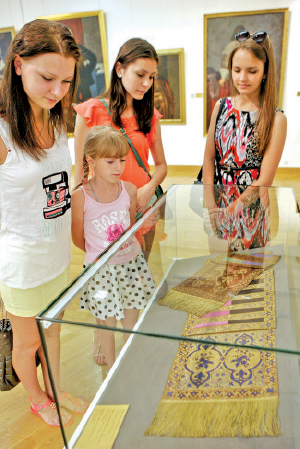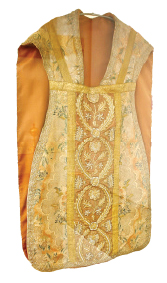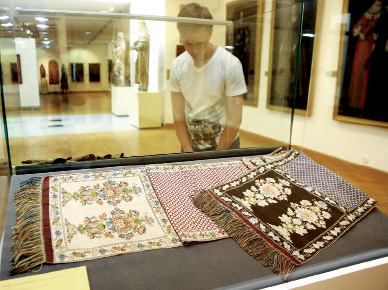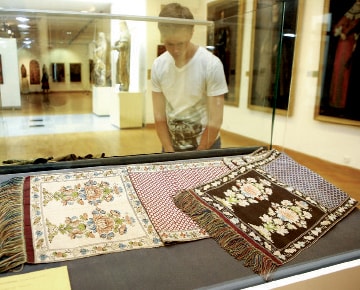The National Art Museum opens a unique exhibition of kontusz belts
 The museum introduced these silk rarities with the help of a Minsk collector who became the initiator of the project. The patron, who wished to remain anonymous, comes from an ancient, gentrified family. He received these historical valuables as heirlooms, and now, residents and guests of the capital can admire his family riches. The collection totals eight belts and a man’s suit owned by the gentry of the Rzech Pospolita.
The museum introduced these silk rarities with the help of a Minsk collector who became the initiator of the project. The patron, who wished to remain anonymous, comes from an ancient, gentrified family. He received these historical valuables as heirlooms, and now, residents and guests of the capital can admire his family riches. The collection totals eight belts and a man’s suit owned by the gentry of the Rzech Pospolita.“Basically, any belt can be called kontusz, as it is put on over the top men’s wear — ‘kontusz’ [a robe-like garment],” explains the curator of the exhibition, who heads the Department of Ancient Belarusian Art of the National Art Museum, Yelena Karpenko.
The belt was always a very important part of a man’s suit. Before the occurrence of the Slutsk manufacturers in first half of eighteenth century, this accessory was brought from Persia, Iran and China. But when it was found out that the demand for them increased, and besides, their cost was huge, Michal Kazimierz Radziwill, using the nickname of Rybeńko, organised their local manufacture in Slutsk.
Slutsk belts differed by their ornamentation. Local flora was used as decoration. For example, one of the belts at the exhibition was weaved with silk and golden threads. Srednik (the middle — biggest — part) is framed by a border along its edge. The centre is divided by strips with decorative ornamentation. If you look closely, the contour is framed with ‘fish scales’. Each side of the belt is decorated with bouquets and flowerpots; characteristic for the late period of existence of Slutsk manufacture.
Colour ranges, and features of weaving show that the museum exhibits one of the best belts of Slutsk manufactory. Its cost is hundreds, or even thousands of Dollars. Actually, the price of this work of art is made of several components — safekeeping, presence or absence of fringe, woven marks.
About twenty grams of gold is other rarity — the heritage of the Leon manufactory. The carrot-red colour, the spiral design of the border and ornamentation confirms the style of the French weavers. Such patterns can be found in tapestries and fabrics for furniture.
As a rule, Leon belts cannot boast a long fringe, while Slutsk belts have double the tassels.
 The work of the Kraków manufactory is one of the most beautiful in the collection. It is a four-sided belt with eastern patterns. Looking at it closely, it is possible to see that its middle is decorated with ‘Turkish cucumbers’, an ornament of drop-shaped form.
The work of the Kraków manufactory is one of the most beautiful in the collection. It is a four-sided belt with eastern patterns. Looking at it closely, it is possible to see that its middle is decorated with ‘Turkish cucumbers’, an ornament of drop-shaped form.“The pattern of this belt differs from Slutsk. They are similar only in length, width and, and in certain places — the presence of fringe,” says Yelena Karpenko.
There was a set of variants of knotting of the kontusz belts. Some of them are illustrated in portraits in the museum hall.
And here is a sample of Russian arts and crafts. As it is known, the silk-weaving industry started to develop in the 18th century in Russia. Peter I supported manufacture and even directed the most talented masters to study in the Netherlands. Daniil Zemsky was one such specialist; he founded a manufactory in Kupavne, situated near Moscow. After his death, the premises were owned by Prince Nikolay Yusupov. At this time, belts had the special marking — ‘К.Ф.’
In Russia, such elements of clothes were weaved from pure silk without the addition of metallised threads. They, by the way, cannot be called kontusz, as kontusz was worn by inhabitants of the Rzech Pospolita over their clothes, Yelena Karpenko explains, “The Russian belts were twice as wide than usual. The pattern also differed from patterns of usual kontusz belts. They were simply called man’s belts, and were also put on over clothes.”
Before being exhibited, the silk rarities were updated. Studying the still future exhibits, experts at the museum concluded that the collector had had the pieces restored. The belts have double fabric and the threads are sewn.
 Here, for the first time, visitors can see traditional clothes of the gentry of the Rzech Pospolita — samples of a man’s suit: żupan and kontusz. It is a single-breasted żupan, with narrow sleeves and a banded collar which was worn under the kontusz. The kontusz is long overclothing with a folding collar. It was put on and tied up with a soft belt.
Here, for the first time, visitors can see traditional clothes of the gentry of the Rzech Pospolita — samples of a man’s suit: żupan and kontusz. It is a single-breasted żupan, with narrow sleeves and a banded collar which was worn under the kontusz. The kontusz is long overclothing with a folding collar. It was put on and tied up with a soft belt.“These clothes were worn since the times of Stephen Báthory and to the last part of the Rzech Pospolita in 1795. After our lands joined Russia, the similar suit was forbidden, though people continued to wear it. Yelena Karpenko notes. “After the revolts in 1830 and 1863, it became dangerous to wear such clothes. But some patriots nevertheless continued to wear them.”
Both elements of the suit are decorated with beautiful silver buttons with turquoise, and if someone wishes to look in detail at this, and the other objects of the undoubtedly interesting and informative exhibition at the National Art Museum, then it is possible to do this till the end of October.
But with all obviousness it is possible to say that the kontusz belts are a unique phenomenon of national art culture. It is difficult to overestimate the contribution of Belarusian masters to the history of West European arts and crafts. The developed artistic taste, innate colouring, an original refined ornamentation, the composite harmony of kontusz belts put them in line with the highest achievements of world artistic culture.











